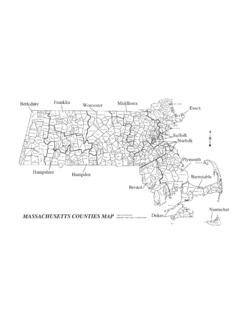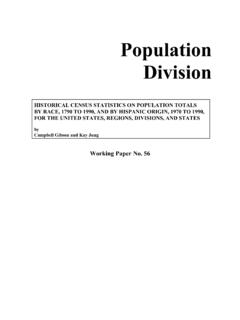Transcription of Understanding Concentrated Animal Feeding Operations and ...
1 Environmental healthUnderstanding Concentrated Animal Feeding Operations and Their Impact on CommunitiesUnderstanding Concentrated Animal Feeding Operations and Their Impact on CommunitiesAuthorCarrie Hribar, MAProject Coordinator Education and TrainingNational Association of Local Boards of HealthEditorMark Schultz, MEdGrants Administrator/Technical WriterNational Association of Local Boards of Health 2010 National Association of Local Boards of Health1840 East Gypsy Lane RoadBowling Green, Ohio healthiiiForewordThe National Association of Local Boards of Health (NALBOH) is pleased to provide Understanding Concentrated Animal Feeding Operations and Their Impact on Communities to assist local boards of health who have concerns about Concentrated Animal Feeding Operations (CAFOs) or large industrial Animal farms in their communities.
2 The Environmental Health Services Branch of the Centers for Disease Control and Prevention (CDC), National Center for Environmental Health (NCEH) encouraged the development of this product and provided technical oversight and financial support. This publication was supported by Cooperative Agreement Number 5U38HM000512. Its contents are solely the responsibility of the authors and do not necessarily represent the official views of the mission of NALBOH is to strengthen boards of health, enabling them to promote and protect the health of their communities, through education, technical assistance, and advocacy.
3 Boards of health are responsible for fulfilling three public health core functions: assessment, policy development, and assurance. For a health agency, this includes overseeing and ensuring that there are sufficient resources, effective policies and procedures, partnerships with other organizations and agencies, and regular evaluation of an agency s is confident that Understanding Concentrated Animal Feeding Operations and Their Impact on Communities will help local board of health members understand their role in developing ways to mitigate potential problems associated with CAFOs.
4 We trust that the information provided in this guide will enable board of health members to develop and sustain monitoring programs, investigate developing policy related to CAFOs, and create partnerships with other local and state agencies and officials to improve the health and well-being of communities special thanks to Jeffrey Neistadt (NALBOH s Director Education and Training), NALBOH s Environmental Health subcommittee, and any local board of health members and health department staff who were contacted during the development of this document for their contributions and Concentrated Animal Feeding operationsivvenvironmental healthIntroduction.
5 1 AFO vs. CAFO .. 1 History .. 1 Benefits of CAFOs .. 2 Environmental Health Effects .. 2 Groundwater ..3 Surface Water.. 4 Air Quality .. 5 Greenhouse Gas and Climate Change.. 7 Odors ..7 Insect Vectors.. 8 Pathogens.. 8 Antibiotics.. 10 Other Effects Property Values.. 11 Considerations for Boards of Health .. 11 Right-to-Farm Laws .. 11 Board of Health Involvement with CAFOs .. 12 Board of Health Case Studies.. 13 Tewksbury Board of Health, Massachusetts .. 13 Wood County Board of Health, Ohio.. 14 Cerro Gordo County Board of Health, Iowa.
6 14 Conclusion .. 16 Appendix A: Regulatory Definitions of Large CAFOs, Medium CAFOs, and Small CAFOs . 17 Appendix B: Additional Resources .. 18 References .. 19 Table of Contentsunderstanding Concentrated Animal Feeding operationsienvironmental health1 IntroductionLivestock farming has undergone a significant transformation in the past few decades. Production has shifted from smaller, family-owned farms to large farms that often have corporate contracts. Most meat and dairy products now are produced on large farms with single species buildings or open-air pens (MacDonald & McBride, 2009).
7 Modern farms have also become much more efficient. Since 1960, milk production has doubled, meat production has tripled, and egg production has quadrupled (Pew Commission on Industrial Animal Farm Production, 2009). Improvements to Animal breeding, mechanical innovations, and the introduction of specially formulated feeds and Animal pharmaceuticals have all increased the efficiency and productivity of Animal agriculture. It also takes much less time to raise a fully grown Animal . For example, in 1920, a chicken took approximately 16 weeks to reach lbs., whereas now they can reach 5 lbs.
8 In 7 weeks (Pew, 2009).New technologies have allowed farmers to reduce costs, which mean bigger profits on less land and capital. The current agricultural system rewards larger farms with lower costs, which results in greater profit and more incentive to increase farm vs. CAFOA CAFO is a specific type of large-scale industrial agricultural facility that raises animals, usually at high-density, for the consumption of meat, eggs, or milk. To be considered a CAFO, a farm must first be categorized as an Animal Feeding operation (AFO). An AFO is a lot or facility where animals are kept confined and fed or maintained for 45 or more days per year, and crops, vegetation, or forage growth are not sustained over a normal growing period (Environmental Protection Agency [EPA], 2009).
9 CAFOs are classified by the type and number of animals they contain, and the way they discharge waste into the water supply. CAFOs are AFOs that contain at least a certain number of animals, or have a number of animals that fall within a range and have waste materials that come into contact with the water supply. This contact can either be through a pipe that carries manure or wastewater to surface water, or by Animal contact with surface water that runs through their confined area. (See Appendix A)HistoryAFOs were first identified as potential pollutants in the 1972 Clean Water Act.
10 Section 502 identified feedlots as point sources for pollution along with other industries, such as fertilizer manufacturing. Consequently, a permit program entitled the National Pollutant Discharge Elimination System (NPDES) was created which set effluent limitation guidelines and standards (ELGs) for CAFOs. CAFOs have since been regulated by NPDES or a state equivalent since the mid-1970s. The definitions of what was considered an AFO or CAFO were created by the EPA for the NPDES process in 1976. These regulations remained in effect for more than 25 years, but increases and changes to farm size and production methods required an update to the permit regulations guiding CAFO permits and Operations were revised in 2003.
















